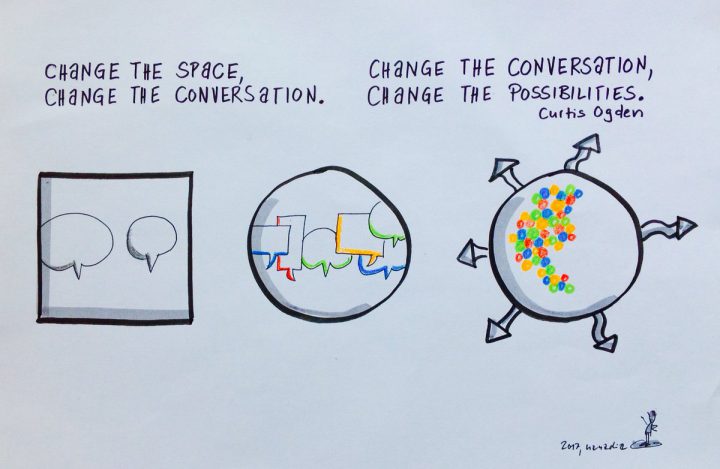Posted in Networks
November 20, 2017
“We know that there is no help for us but from one another, that no hand will save us if we do not reach out our hand.”
– URSULA K. Le GUIN

Image by Stephen Bowler, shared under provisions of Creative Commons Attribution license 2.0.
A note on the quotes below (and the Le Guin quote above): I am grateful for the beautiful piece by Evan Bissel, “Frames for Life, Liberation and Belonging,” which appears in the Othering and Belonging Journal. This piece lifts up some central elements of an emerging and humanizing narrative for our times, with focus on themes such as transition, liberation, belonging, commons, interconnection, abundance, sacred, curiosity, play, and place. I strongly encourage readers to check it out, to sit with the piece and let it soak in, and to share it.
This post follows the thread of a conversation that has been evolving across events I have been involved with the past few months, and a bigger and broader conversation that is clearly informing it. This is certainly not a new conversation, but there seems to be a renewed or perhaps more public vigor to it, at least in multi-racial and multi-generational social change groups and initiatives with which I have been involved.
It has cropped up in a network leadership program where a discussion about the difference between working for equity and working for justice pointed in the direction of the need to pursue liberation, and not simply inclusion and accommodation in fundamentally harmful systems. Read More
October 24, 2017
“Relationship is the fundamental truth of this world of appearance,”
– Tagore
Over the past several years of supporting networks for social change, we at IISC have been constantly evolving our understanding of what is new and different when we call something a network, as opposed to a coalition, collaborative or alliance. On the surface, much can look the same, and one might also say that coalitions, collaboratives and alliances are simply different forms of networks. While this is true, it is also the case that not every collaborative form maximizes network effects, including small world reach, rapid dissemination, adaptability, resilience and system change. In this regard, experience shows that a big difference maker is when participants in a network (or an organization, for that matter) embrace new ways of seeing, thinking, and doing. The following revised list continues to evolve as our own practice and understanding does, and it speaks to a number of network principles to guide thinking and action:
October 2, 2017
“We cannot live for ourselves alone. Our lives are connected by a thousand invisible threads, and along those sympathetic fibers, our actions run as causes and return to us as results.”
– Herman Melville
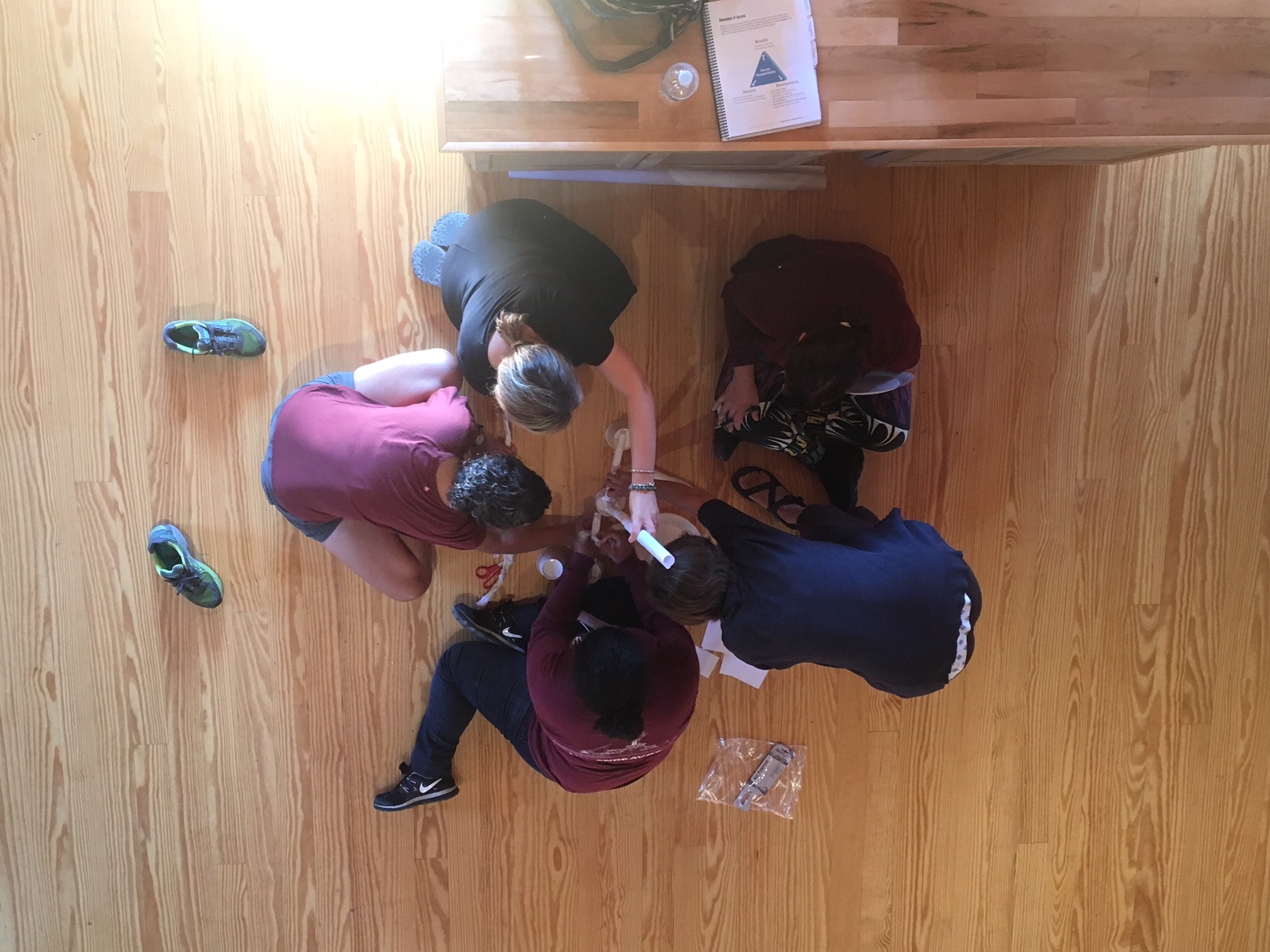
2017-2018 NLI cohort members engage in a team building exercise focused on the dimensions of collaborative success.
Last week I worked with the Backbone Team of Food Solutions New England to launch the second cohort of the Network Leadership Institute (NLI) at Ohana Camp in Fairlee, Vermont. This initiative has grown out of FSNE’s commitment to cultivating both thought leadership and network leadership “to support the emergence and viability of a New England food system that is a driver of healthy food for all, racial equity, sustainable farming and fishing, and thriving communities.” Another impetus for the NLI was a year spent doing system mapping and analysis that revealed four leverage areas for advancing a just, sustainable and democratically-owned and operated regional food system, including cultivating and connecting leadership (see image below). Read More
August 15, 2017
I love Twitter.
On the heels of the Hunts Point Resiliency Collaboration Lab (about which a blog post is forthcoming) that a team of us from IISC facilitated a couple of weeks ago, I tweeted the following –
“Change the space, change the conversation. Change the conversation, change the possibilities.”
Without getting into all of the details, by shifting what might otherwise might have been a typical meeting through the use of art, music, tactile objects, intentional arrangement of seating, delicious food, robust opportunities for interaction, etc., those in attendance acknowledged that we were able to get to authentic and important conversations that many had been eager to have. And these have opened some opportunities about which people are very excited.
My almost off-handed tweet was picked up and retweeted by a few people, including Nadia von Holzen, who then put together the wonderful graphic above and put it back into the Twittersphere. I love the enhancement and contribution. Thanks, Nadia!
This is another example of what can happen when you “think or work out loud.” In this intricately connected world, you never know who is listening and what gifts they stand poised to bring to your humble offerings.
August 8, 2017
I am saddened to learn that Mila Baker passed away recently. While I did not know her personally, she was a mentor from a distance. A few years ago, I read her book about peer-to-peer leadership and found it both enlightening and validating as I continued my journey to uncover more about the promise of seeing and doing in networked ways.

Mila N. Baker
Mila Baker was a writer, teacher, philanthropist, cross-sector leader and artist. At the time of her passing, she served on the Board of Directors for the Berrett-Koehler Foundation, was a member of the adjunct faculty at Columbia University Teachers College, as well as a Principal Research Investigator at the Institute for Collaborative Workplaces, and Visiting Professor at Kuwait University. The following is a post I wrote after reading her book published in 2014.
I just finished reading Mila Baker’s Peer-to-Peer Leadership: Why the Network is the Leader, which adds to the growing case for more widespread network thinking, foregrounding of human relationships, and shifting traditional conceptions (and myths) of leadership in business and beyond. Baker’s book echoes the spirits of Margaret Wheatley, Clay Shirky, Carol Sanford, Nilofer Merchant, Kevin Kelly, and Harold Jarche, and I appreciate how she couches her writing in the evolving leadership and organizational development literature and thinking.
Read More
July 11, 2017
“Mutual learning is only possible when all participants are willing to be wrong … willing to learn, to explore new ideas, to go off the map, out of the known, and together grope in the shadowy corners of new ideas, new plans, new territories.”

“Expertise” is one of those concepts that seems to get a good vetting every now and then, and in the current climate of VUCA (volatility, uncertainty, complexity, ambiguity) and networked approaches to change, there is certainly good reason for this. Mark Twain once quipped that what made the expert an expert was being from someplace else. There may be some truth and value to this view; when a set of “outside” eyes can lend fresh new perspective to a situation. And it is also the case that deference is often given to this version of expertise at the expense of local and other diverse sources of knowledge. Read More
June 13, 2017
“Life moves toward other life… If we trusted more in these cohering motions, we could move into an essential role … supporting the system to explore new connections, new information, new ways of being. It means focusing on opening the system in all ways.”
Margaret Wheatley and Myron Kellner-Rogers, a simpler way
“Bridging” in the work of network development speaks to the act of creating connections between socially heterogeneous groups (or putting it a bit more crassly, building bridges between “us” and “them”). The benefits of bridging include making it possible for diverse groups to share and exchange information, creating new forms of access, as well as leveraging new ideas and spurring innovation between groups representing different interests and/or backgrounds. Bridging widens social capital by increasing the “radius of trust.” Unlike “bonding,” or more in-group relationship building (think “birds of a feather flocking together”), bridging can help create more inclusive structures that can have implications for long-term resilience and more equitable development. The following is a story of a network engaging in intentional bridging work for more robust connectivity, flows and opportunity …
Food Solutions New England (FSNE) is a regional, collaborative network organized to “support the emergence of a New England food system that is a resilient driver of racial equity and food justice, sustainable farming and fishing, and thriving communities.” FSNE is convened by For the past 5+ years, IISC has worked with the convening “backbone organization,” UNH Sustainability Institute, to launch and structure itself as a formal network, as well as to concretize and evolve its core commitment to racial equity as it has become more diverse and inclusive and worked for systemic change.
Eighteen months ago, FSNE was faced with making a decision about where to hold its annual Food Summit. The Summit was originally conceived to bring together delegates from across New England to strengthen collaboration for regional food system sustainability. The commitment was made early on by the convenor to move the Summit around the region, holding it in each of the six New England states once before going to any of them for a second time.
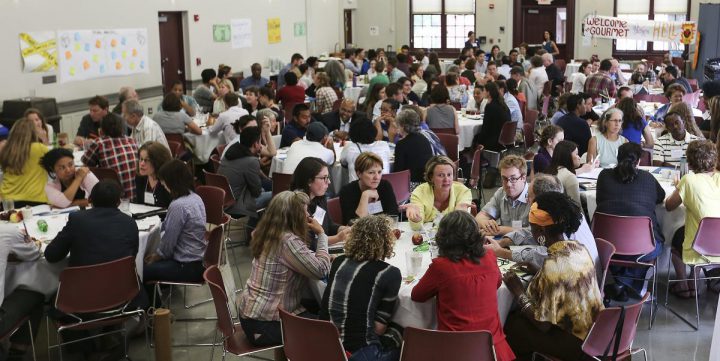
Delegates to the 2015 New England Food Summit gathered in Boston, MA.
In 2016, Connecticut was the last state to host the New England Food Summit. The network’s backbone organization was faced with a decision about the specific location within the state. Previous Summits had been held in prominent hubs in the other states – Portsmouth (NH), Burlington (VT), Portland (ME), Pawtucket/Providence (RI) and Boston. While places like Hartford and New Haven might have been natural considerations given their respective amenities and relative centrality in the state, the choice was made to bring the Summit to Bridgeport. This decision was spurred in no small part by the leadership of State Senator Marilyn Moore, who hails from that city and is a member of the FSNE Network Team. Senator Moore pointed out that not only would it be significant for Bridgeport to play host, given it is often overlooked in favor of its more well-known and regarded neighbors, it would also be enlightening for Summit delegates to see reality on the ground. Furthermore, this choice was viewed as an expression of FSNE’s commitment to racial equity and food justice.
Read More
May 29, 2017
I recently received an email from the NorthSky Nonprofit Network about a practice group they have called the “Network Sandbox.” They introduce a tool (for “Tuesday Tool Time”) and invite members to play with it. I was happy to be told that they recently incorporated “connection stories” as a tool. Here is their invitation to participants to stretch and innovate:
This week’s tool is inspired by the new connections catalyzed by the mini-grants. While the survey we used collected some anecdotal information about the new connections, it left all of us wanting more… richer, deeper stories about these connections. Curtis Ogden from the Interaction Institute for Social Change (IISC), calls connection stories “critical nutrients” for networks that “feed a network forward.”
Tool: Connection Stories
Source: Interaction Institute for Social Change
Purpose: Collect and share stories of connections that have happened because of networks and share them back to the network to inspire more of the same.
From Curtis’s blog: Making these stories more explicit and accessible can have a number of different impacts:
- They model the importance of reaching out across boundaries and to “the other”
- They encourage network behaviors that build a foundation of trust and understanding, which …
- Contribute to “network effects” such as resilience, adaptation, and innovation.
- They can encourage cultures of equity, inclusion and diversity.
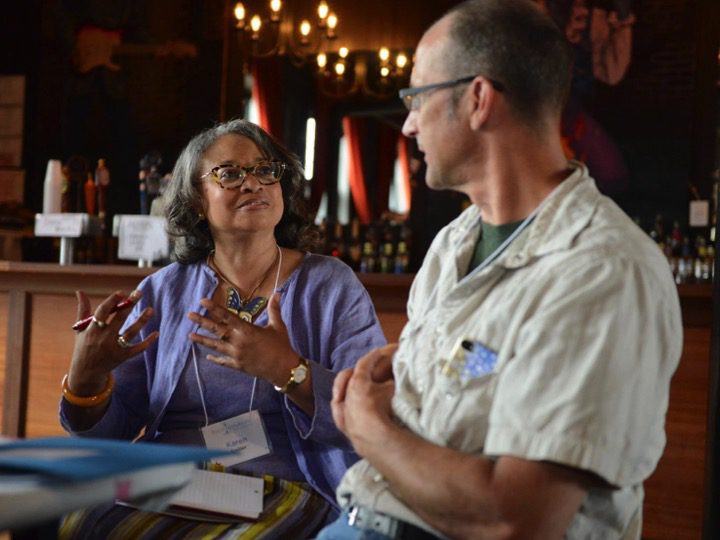
May 8, 2017
“Clearly, we made some people uncomfortable. Good. For too long, our comfort has come on the backs of many who have been uncomfortable for a long, long time.”
–Niaz Dorry, FSNE Process and Network Team Member
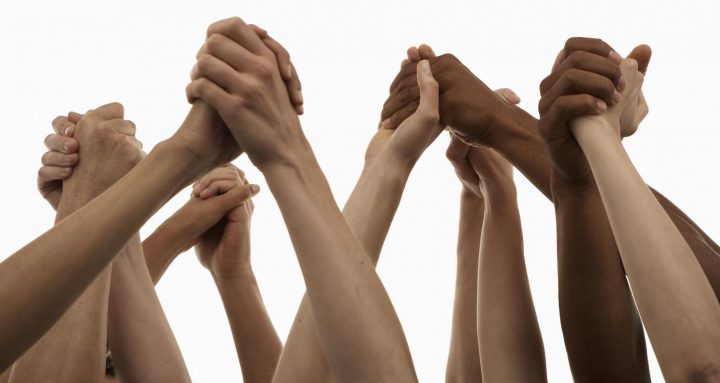
Food Solutions New England (FSNE) is a regional, collaborative network organized to “support the emergence of a New England food system that is a resilient driver of racial equity and food justice, sustainable farming and fishing, and thriving communities.”
For the past 5 years, IISC has supported FSNE to launch and structure itself as a formal network, as well as to concretize and evolve its core commitment to racial equity as it has become more diverse and inclusive and focused on systemic transformation. Over the winter, editorial staff from the Othering and Belonging Journal at the Haas Institute for a Fair and Inclusive Society solicited an article submission from FSNE to tell the story of why and how the network has operationalized its commitment to racial equity and food justice.
“While Othering processes marginalize people on the basis of perceived group differences, Belonging confers the privileges of membership in a community, including the care and concern of other members. As [john a.] powell has previously written, ‘Belonging means more than just being seen. Belonging entails having a meaningful voice and the opportunity to participate in the design of social and cultural structures. Belonging means having the right to contribute to, and make demands on, society and political institutions.'”
–Andrew Grant-Thomas, from Othering and Belonging Editors’ Introduction
The article was published last week under the title “Equity as Common Cause,” co-authored by El Farrell, Tom Kelly and Joanne Burke of the UNH Sustainability Institute (the convenor of FSNE), Karen Spiller of KAS Consulting and the Albert Schweitzer Fellowship (Karen is lead FSNE Ambassador) and myself, as network facilitator, with input and voices of many others, including Connecticut Senator Marilyn Moore, Julius Kolawole of the African Alliance of Rhode Island and Niaz Dorry of North Atlantic Marine Alliance. Read More
April 25, 2017
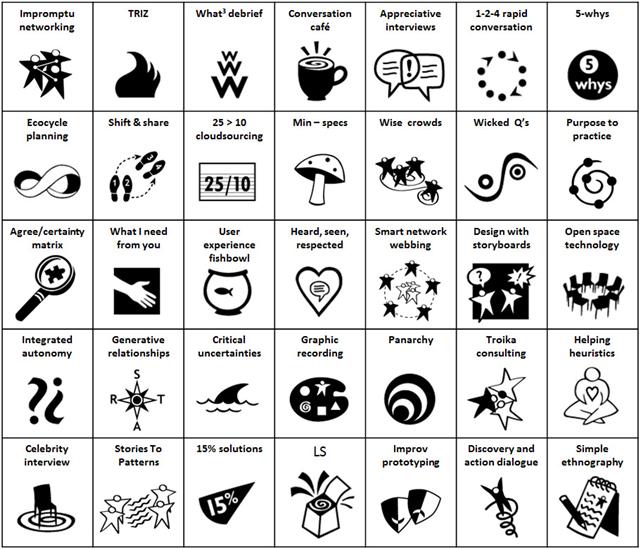
With inspiration from Nancy White – thank you! (and make sure to check out Nancy’s blog) – I have been returning to and reviewing the list of Liberating Structures created and collected by Henri Lipmanowicz and Keith McCandless for application to some strategy development work with a couple of social change networks. As described on the website:
Liberating Structures are “easy-to-learn microstructures that enhance relational coordination and trust.
Liberating Structures are meant to foster enlivening participation in groups of all sizes, making it possible to truly include and unleash everyone.”
In reviewing the various structures, I’ve pulled out and added to a list of strategic questions that could be offered in concert with different group processes (World Cafe, Open Space, pair shares, fishbowls, individual reflection, etc.) to open up possibilities … Read More
April 19, 2017

In sustainable agriculture you hear talk about no and low-till farming. These are approaches that emphasize minimal disturbance of soils to preserve their structural integrity and also to keep carbon in the ground. No-till increases organic matter, water retention and the cycling of nutrients in the ground. As a result it can reduce or eliminate soil erosion, boost fertility and make soils more resilient to various kinds of disruptions. This flies in the face of mainstream approaches that recommend ongoing and significant intervention, “fluffing” soil and digging down to considerable depths to get rid of weeds and aerate the ground. What actually happens can be quite destructive to the long-term productive and regenerative capacity of the soil.
“When we harvest, weed, rake or trim gardens and landscapes, we remove the organic material that feeds the soil.”
I like this as a metaphor for what can happen when there is failure to see and respect the networked structures that already exist in communities, organizations and other living systems. Read More
April 4, 2017
“You’ve got to keep asserting the complexity and the originality of life, and the multiplicity of it, and the facets of it.”
– Toni Morrison

Once again, I’ve been re-reading Niels Pfleaging’s short book Organize for Complexity (and eager for the release of the English version of Complexitools) amidst the growing demand we are hearing at IISC from people who want to liberate their organizations and themselves to be able to intelligently respond to change and to come back to life! Here’s the gist – as things shift more, and more rapidly, some people’s inclination may be to try to exert greater control or dig in to what is familiar, but does not work. The more one does so, the worse things can get. As Pfleaging writes, we see a “high price for the illusion of control.” Within organizations this takes the form of various gaps – social, functional, and temporal – that make them increasingly irrelevant, ineffective and irresponsible.
Responding to complexity requires (to borrow a phrase from Eugene Eric Kim) new muscles and mindsets.
Read More



